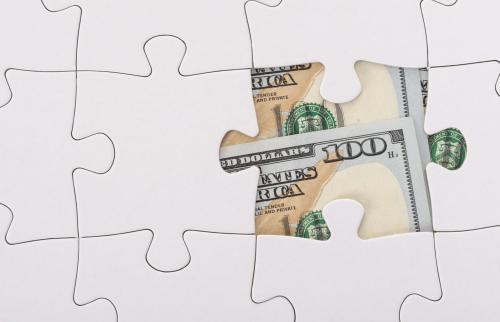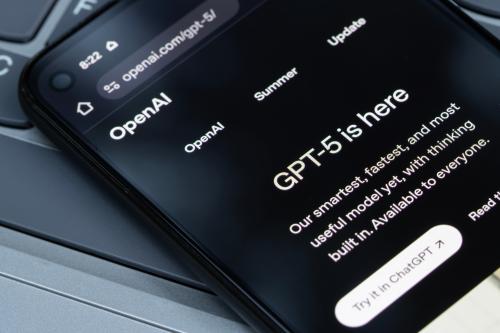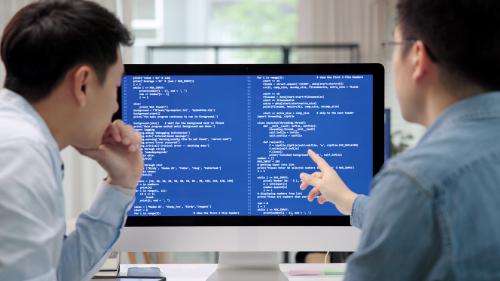Introduction
Income driven repayment (IDR) plans provide student loan borrowers with insurance against unaffordable payments when their income is low by setting payments to be fraction of discretionary income rather than a fixed payment for ten years. Most IDR plans, however, are currently in legal limbo due to litigation against the newest IDR plan developed by the Biden administration. This legal uncertainty is likely to be resolved by Congress through the reconciliation process: The House has passed a bill that includes major changes to the student loan program, including IDR. Under the House bill, existing IDR plans would be closed to new borrowers and replaced with a new program, the Repayment Assistance Plan (RAP). As of this writing, the Senate version of the bill has similar loan repayment provisions.
RAP differs from existing IDR plans along several dimensions, which would mean higher monthly and/or lifetime payments for some borrowers and lower payments for others. One difference between RAP and earlier IDR plans is that RAP requires a minimum monthly payment of $10, regardless of a borrower’s income. In contrast, under existing IDR plans, borrowers pay nothing—they have a “$0 payment”—if their income is below a “protected income threshold,” which ranges from 100-225% of the federal poverty line, depending on the plan.
In this brief, we discuss the potential benefits and costs of requiring a minimum payment in IDR plans and identify policies that could complement or substitute for a minimum payment requirement.
The principle: Borrowers should make payments on loans
Some feel it is important, in principle, that borrowers make at least a token payment. The stated goal of RAP is to “encourage responsible borrowing and timely repayment” and establish “accountability for students.” From this perspective, a minimum payment emphasizes that loans are different from grants and need to be repaid.
A minimum payment could also help borrowers—especially those just entering repayment who are often relatively young—understand their repayment obligations and develop a habit of making payments on their loans. Another provision of RAP ensures that borrowers see their balance decline by at least $10 per month as long as they make on-time payments, which could have psychological benefits—especially compared to the situation under some existing IDR plans where loan balances can increase when payments aren’t enough to cover the accrued interest. On the other hand, borrowers with stagnant incomes who only make the minimum payment will make very slow progress reducing their balances, and the extended length of repayment may deter some borrowers from switching to this IDR plan, even if it could benefit them.
Minimum payments may help keep borrowers connected with the student loan repayment system
Proponents of RAP argue that requiring nonzero payments—especially if those payments lower the principal balance—will keep borrowers more engaged with the repayment system. While a $0 payment under existing IDR plans helps protect low-income borrowers against unaffordable payments, it means borrowers do not have a monthly obligation to keep them connected with the repayment system. This disengagement could reduce the likelihood they are able to comply with the requirement to reapply for IDR on an annual basis.
Recent research provides some support for the idea that borrowers who aren’t required to make loan payments can become disconnected from the system. A study of borrowers who applied for IDR between 2015 and 2018 compared those who just missed the income cutoff to qualify for a $0 payment (and thus faced a $10 monthly payment) with those who qualified for a $0 payment because they had incomes just below the threshold. In the first year, those who qualified for a $0 payment had lower rates of delinquency (missing at least one payment) and default (missing at least nine months of payments) compared to borrowers who had similar incomes but faced a $10 monthly payment. This reduction in repayment difficulties suggests that in the shorter run, a $0 payment does indeed help protect borrowers from the negative consequences of missing payments. At the same time, these benefits are largely mechanical as it is not possible to be delinquent with a $0 payment.
In the longer run, however, the beneficial effects of having a $0 payment on delinquencies and defaults fade or even disappear, as borrowers who initially qualified for a $0 payment see increased delinquency and default rates in subsequent years. While the cumulative risk of delinquency was still somewhat lower up to three years after they initially applied for IDR, most of the initial benefits are due to a retiming rather than longer-run reduction in repayment struggles.
This is because borrowers who qualified for a $0 payment in their first year on IDR were less likely to complete the recertification process, so they were moved to alternate repayment plans with substantially higher payments. This suggests that waiving the requirement to make a monthly payment may have led inattentive borrowers to lose touch with their servicers over the course of the year.
Although recertification procedures have been somewhat streamlined since the time period covered by this study—with the 2019 FUTURE Act allowing borrowers to provide consent to share their income tax returns to aid in the recertification process—borrowers on IDR may still struggle to comply with this requirement, especially if they have fewer opportunities to engage with their loan servicer.
Even small payments can be a hardship, and missed payments are costly
For very low-income families, finding $10 a month to make a student loan payment can be difficult, and the consequences of missed payments can be substantial. The study of borrowers who first enrolled in IDR between 2015 and 2018 found that a substantial share with income-based payments of $10 per month (the smallest non-zero payment) failed to make that payment, even though they had higher incomes than would borrowers making the minimum payment under RAP. Over 15% of those who had income just above the $0 payment threshold were delinquent during the first year on IDR, almost 2.5% defaulted, and about 5% entered forbearance. The analysis suggests that the missed or delayed payments are primarily due to borrower inattention or the fixed cost of making any payment rather than the amount of the payment; that is, a $1 payment would likely have similar effects.
On the RAP plan, low-income borrowers who have volatile income or experience unemployment may miss payments and see their balances grow, as the principal and interest subsidies are only applied when borrowers make on-time payments. Once a borrower is at least 90 days late, the delinquency is reported to the major credit bureau agencies and borrowers may see their credit scores drop (though they may already have limited credit access due to low income), their wages garnished, and their Social Security and tax refunds withheld. A month when a borrower misses a payment also doesn’t count towards forgiveness, whereas months in which borrowers qualify for $0 payments on current IDR plans do count.1 Finally, other existing options to help borrowers avoid delinquency and default in times of low income, including economic hardship and unemployment deferments, would also be eliminated under the House-passed bill.
Collecting small payments can be more trouble than it’s worth
The government (through its contracted loan servicers) faces a fixed cost of collecting a payment—the advent of electronic payments has reduced this cost, but it is not zero. The borrower may also face a fixed cost of the payment, particularly if it is not automated—they must remember to pay and make sure funds are available in their account at the right time. Imagine the minimum payment were just $1, as in the College Cost Reduction Act proposal put forth by Republican Congresswoman Virginia Foxx in 2024.2 This would largely eliminate the concern about the lowest-income borrowers being able to afford the payment but with the tradeoff that the government would likely lose money to collect the payment. It is not clear whether $10 is above or below the cost of collection, but it could be near it. Even if collecting a payment costs less than $10, the total savings to the government from requiring a $10 minimum payment is surely small, especially compared to other provisions of the legislation.
Other approaches could help
Instead of or in addition to a $10 minimum payment, the government could take other approaches to keep people connected to the loan repayment system.
Part of the problem with the repayment system is that it has a long history of being badly administered: Student loan servicers regularly make payment processing errors, provide incorrect repayment information, and are difficult to contact. Improved funding, oversight, and/or contracts between the Department of Education and student loan servicers could all help improve the loan repayment system as a whole and the IDR application and recertification processes in particular.
Further changes to the recertification process could also help borrowers remain connected with the student loan system without imposing a minimum payment requirement. Under the 2019 FUTURE Act, borrowers can automate their annual IDR recertification of income and family size using IRS data, but they are required to opt in, which may limit participation.3
Improved outreach may also increase engagement with the repayment system. A 2023 field experiment tested the impact of different messaging interventions on borrowers’ outcomes. Millions of borrowers were sent emails that nudged them to apply for IDR and sign up for auto-debit payments at the end of the COVID-19 student loan repayment pause. The authors find that the emails reduced estimated delinquencies by 0.42 percentage points. In other words, if scaled to all 13 million participants in the study, the most effective email could have prevented between 58,000–102,000 additional borrowers from lapsing into delinquency. It could be worth improving outreach that encourages borrowers to, for example, consent to automatic recertification using their tax returns.
IDR payments could also be further automated. For example, in the U.K. and Australia, student loan repayments are automatically withheld from workers’ paychecks by their employers. This also would increase the insurance value of IDR as payments would immediately fall when a borrower’s income falls, whereas the retrospective nature of the calculation of IDR payments in the United States means that the income being used to determine payments is at least a year old. Although borrowers can provide documentation of a more recent drop in income, this process is by no means automatic. Policymakers should look for ways to streamline repayment so that borrowers are less likely to become disconnected from the system whether there is a minimum payment or not.
While the $10 minimum payment mainly targets lower-income borrowers, the reforms discussed here would have benefits that extend to all borrowers. Even before the legal challenges to IDR plans, many borrowers have struggled to navigate the repayment system and failed to complete their annual recertifications.
Conclusion
In a departure from earlier income-driven repayment plan designs, the House-passed Repayment Assistance Plan (RAP) would incorporate a minimum payment of $10 per month. On the one hand, requiring all borrowers to make at least some payment may encourage connection and engagement with the repayment system and help borrowers new to repayment form good habits around loan repayment. On the other hand, paying even $10 a month can be a real hardship for some borrowers, requiring payments may increase hassle costs for borrowers, and the payment may not even cover the cost of collecting the payment.
Regardless of where Congress lands on these trade-offs, making sure that Federal Student Aid (FSA) has sufficient funding and staffing to administer IDR effectively and communicate the changes to servicers and borrowers will be critical.
-
Footnotes
- Under most current IDR plans, remaining balances for most borrowers are forgiven after 20 to 25 years of payments; under the proposed RAP, the time to forgiveness would be 30 years.
- In the 2024 CCRA proposal, borrowers who make a minimum monthly payment of $1 would have their unpaid interest waived.
- Senate rules prevent the committees responsible for IDR design to include provisions in a reconciliation bill that would allow automatic certification using data collected by the IRS by default; the requirement that borrowers provide consent to have their tax return information accessed for this purpose was a compromise between the committees responsible for education and taxes.
The Brookings Institution is committed to quality, independence, and impact.
We are supported by a diverse array of funders. In line with our values and policies, each Brookings publication represents the sole views of its author(s).









Commentary
Minimum payments in income driven repayment plans
July 2, 2025